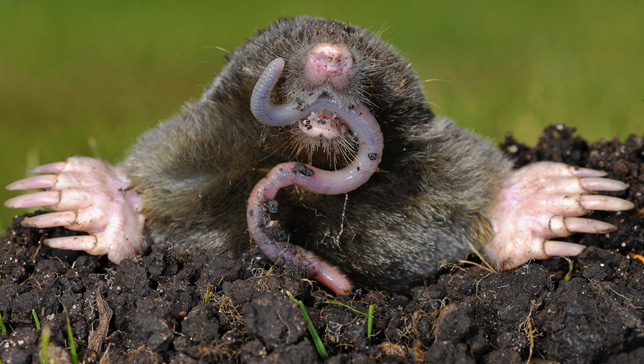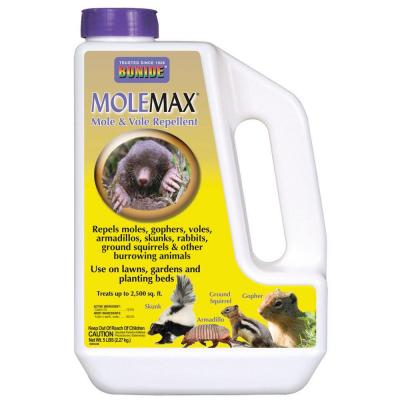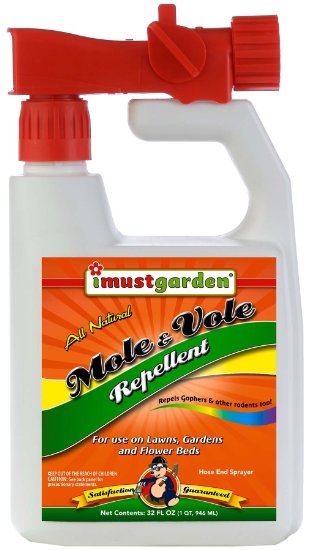Mole and Vole Prevention
All About Moles
Moles live a solitary life, constantly digging tunnels in search for food. Large front claws distinguish this small animal from a vole or mouse. A mole can dig up to 15 feet per hour. An adult mole is colored gray to brown and grows to a size of 6 to 8 inches.

They don’t hibernate and will tunnel under the frost line in winter. Moles reproduce once a year, in the spring, and will only produce 3 or 4 offspring. Spring tunneling in most noticeable.Trying to remove moles from your yard may involve traps, poisons, some old fashion home remedies, and lots of patience. Many folks prefer to get rid of them without the use of poisons or traps. There are products on the market today that we can use to repel as well as some to prevent moles. First let’s talk about prevention. Preventative measures should center on their food source. Moles are insectivores, meaning they eat insects such as earthworms and grubs. Most damage to plant life is done while burrowing for insects when they uproot the plants and disturb the grass roots.
How to Get Rid of Moles
Getting rid of the grubs will cause the moles to search elsewhere for food. A product named Bacillus popilliae or Milky Spore can be spread over the grass.

This product will decrease the grub population and your yard will no longer be an attractive source of food for moles. To completely get rid of the grubs, it is recommended that you apply Milky Spore in late spring, summer and again in fall. Repeat this process for two consecutive years to obtain optimum control. This will kill all three life cycles of the grub. Did you know that grubs grow up to be Japanese Beetles? It’s true. So while you are eliminating the grub population, you are also eliminating the Japanese Beetles.
All About Voles
Voles are vegetarians and feed on bulbs, roots and the bark at the base of young trees or shrubs. They are closely related to mice and greatly resemble them, too.

There are two common types of voles. Pine voles burrow beneath the ground and have holes about one to three inches in diameter. They generally stay in one local area, even around one tree. Pine voles only damage plant parts beneath the ground. Meadow voles live and nest above ground. They do not create holes or tunnels and are not confined to one area. They only damage plant parts above ground. Voles breed throughout most of the year with peaks in the spring and fall. Meadow voles normally have five to ten litters per year and average three to five young per litter. Pine voles have one to six litters per year and average two to four young per litter. The gestation period is about 21 days.

Vole Prevention
One of the best ways to control voles is to send a cat out on patrol. Cats love hunting for rodents. Snap traps manufactured mainly for mice also are effective at catching voles. A 50-50 mix of peanut butter and oatmeal is a favorite bait, and so are small apple slices. For maximum effect, place traps along active runs and disguise them with an inverted box and/or leaves and grasses (with the vegetation out of the way enough that it doesn’t impair the traps). If you don’t want to kill the voles, use the same baits in a cage trap. When the vole trips the plate, the doors close. Then you can relocate voles – preferably at least a half mile away in a place that won’t cause damage for someone else.

To discourage voles from tunneling into beds, try digging sharp materials into your soil. Products such as Permatill are ideal for this purpose, and even coarse gravel may do the trick. About 10 percent gravel to 90 percent soil is enough to make tunneling uncomfortable for a vole. In existing beds, channels of this material can be dug a few inches vertically into the perimeter, creating a kind of gravelly moat around a flower bed. Permatill can be used in bulb beds as well. Another option is lay sheets of chicken wire over the top of the beds to prevent voles and other rodents from burrowing down in; or the bulbs can be completely surrounded by wire to protect them from all angles. Bulb shoots will poke through the openings. You may need to spray mole/vole repellents to keep the voles from eating live plants and bulbs once they have sprouted.
Store Bought Vole Repellents

There are several repellents on the market that are effective on moles and voles. Some are in the form of a spray, some are granule and there are also electronic repellents. Most repellents will work on moles and voles. Liquid Fence and I must Gardens are liquids that come in a ready-to-use bottle with a trigger spray or a ready-to-use hose-end sprayer that you attach to your garden hose. They also offer a concentrated formula that you mix with water and put in a standard lawn sprayer. These typically last up to four weeks and then must be reapplied. They are made of all natural ingredients and are safe for use around children and pets. MoleMax is a clean, dustless, biodegradable granule that you spread on the grass just like you would fertilizer. It is safe for use around children, plants and pets and lasts up to three months. The active ingredient is Rucinus Communis Oil or Castor Oil.

DIY Methods of Vole Prevention
Here are a couple of home remedies that have proven useful. Moles dislike cats so place well-used kitty litter in mole entrance holes and active mole runs and the moles will usually leave. Moles do not like Castor oil either. Here’s a good mole control recipe: Mix 3 ounces of Castor oil with 4 tablespoons of liquid dishwasher soap in I gallon of water and pour this mixture in the mole tunnels. It is very difficult, if not impossible, to be rid of moles and voles forever. Hopefully, this information will help you control these little critters. All the products mentioned are available here at Fairview Garden Center.
Good Luck!




